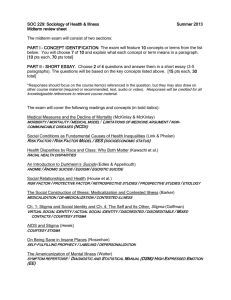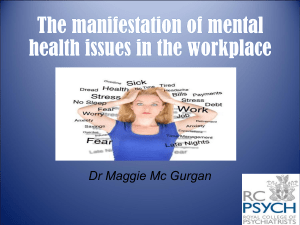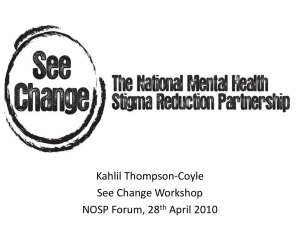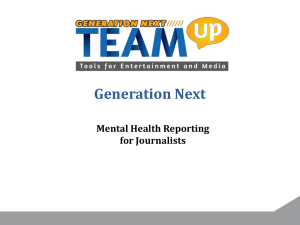WISE Basics Presentation (Lite)
advertisement
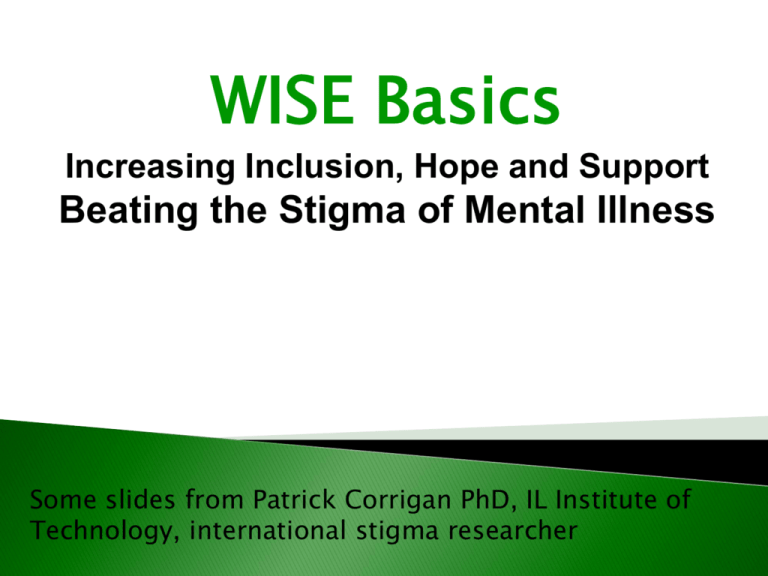
WISE Basics Increasing Inclusion, Hope and Support Beating the Stigma of Mental Illness Some slides from Patrick Corrigan PhD, IL Institute of Technology, international stigma researcher Statewide collaboration of organizations and individuals. Promote evidence based practices, current research and outcomes evaluation. Majority speak from experience of stigma and recovery. Offer insights, resources, and support for stigma reduction WISE Active Partners: Care Connections (Waukesha County NAMI Support Group) Center for Suicide Awareness COPE Services Dry Hootch Grassroots Empowerment Project Illinois Institute of Technology LaCrosse Mental Health Coalition Latino Health Coalition – Mental Health Action Team MHA Wisconsin Milwaukee Center for Independence Marian University NAMI WI, Greater Milwaukee & Racine Prevent Suicide WI Rogers InHealth University of WI Milwaukee and Madison WI Department of Health Services WI Family Ties WI United for Mental Health ETC. 1 in 4 anxiety schizophrenia trauma depression 47% in ourDrug lifetime and eating disorders alcohol abuse EPIDEMIC? Stigmaand Types Stigma Definition Definition Types Stereotype-ideas Internalized Shame Prejudice-beliefs Public Discrimination- Structural actions 5 Internalized Shame Public Stigma self esteem I am not good sense of efficacy I am not able So, why try? Avoidance and apathy Racial Discrimination 7 Religious Discrimination 8 Gender Discrimination Drivers of Public Stigma Movies Newspapers Advertising Unethical Research, Drug Side Effects & Poor Quality Care 10 “Benevolent” Stigma People with mental illness are lovable and incapable. 11 OK, but isn’t it better lately? 12 July th 10 , 2002 Trenton State Hospital has fire. 14 Despite what you might think, the percentage of Americans who viewed people with mental illness as dangerous doubled from 1956 to 1996…. and remained high into 2006 % who viewed those with mental illness as dangerous 100% 80% 60% 40% 20% 40% 40% 1996 2006 20% 0% 1956 Source: BG Link, JC Phelan, M Bresnahan, A Stueve, BA Pescosolido American Journal of Public Health 89 (9), 1328-1333 Public Stigma: It’s Impact on SOCIAL INCLUSION Lost employment Subpar housing Worse health care Diminished education opportunities Alienated from faith community Stigma Change Processes Protest Education Contact 17 Protest ◦ Review stigmatizing images ◦ “Shame on you for thinking that way” 18 Unintended consequences of well intended actions “The white bear” Beware of the rebound effect 19 Education Review key myths and facts that counter these myths 20 Myth: People with serious mental illness can not care for themselves; need to be institutionalized. Fact: Long term follow-up research suggests 2/3rds of people with schizophrenia learn to live with their disabilities. RECOVERY is the rule Myth: People with serious mental illness are dangerous. Fact: People with untreated mental illness are slightly more dangerous especially when using drugs or alcohol BUT… ◦ They are more likely to be victims of violence META-ANALYSIS FINDINGS: CAUSE Brain Disease 80 70 60 50 Sz Dep 40 30 20 10 0 1990 1994 1998 2002 2006 Schomerus, Schwann, Holzinger, Corrigan, Grabe, Carta, & Angermeyer, 2011 META-ANALYSIS FINDINGS: ACCEPTANCE Neighbor 60 50 40 Sz Dep 30 20 10 0 1990 1994 1998 2002 2006 Schomerus, Schwann, Holzinger, Corrigan, Grabe, Carta, & Angermeyer, 2011 Contact “Meet John, Mike, Charles, Tim, and Mark” 25 Their Recovery Story ◦ My name is ______ and I have a mental illness and/or addiction… ◦ My childhood was… (normal/traumatic) ◦ My mental health challenges were difficult for me and others. They did not go away quickly… ◦ Combining my internal resources with external resources, I found recovery… ◦ I have achieved a satisfying life with several accomplishments. 26 A process of change through which people work to improve their own health and wellbeing, live a selfdirected life, and strive to achieve their full potential. SAMHSA’s four essential dimensions of recovery: ◦ ◦ ◦ ◦ Health Home Purpose Community TLC4 Targeted Local Credible Continuous Change-focused Contact 30 Who Should the TARGETS Be? Health care professionals Employers Landlords Teachers Legislators Faith communities What is LOCAL Contact? x Does it play in Wausau? MILWAUKEE What is CREDIBLE Contact? Contact with peer Example- • Nurse to nurse • Pastor to pastor • Football player to football player 33 CONTINUOUS Contact Once is not enough And variety is needed 34 CHANGE-FOCUSED Contact What do you want the target group to do differently as a result of the contact? TLC4 Targeted Local Credible Continuous Change-focused Contact 36 Speak up everyone Speak up everywhere Honest, Open & Proud “strategic disclosure” Levels of Disclosure Social Avoidance – avoid situations Secrecy – work to keep it a secret Selective Disclosure – share it with select people Open Disclosure – no longer hide it Broadcast Your Experience – actively share it 39 39 Your Recovery Story Reversing Self and Public Stigma Inclusion and Support self esteem I am good sense of efficacy I am able Public Stigma I care for myself & others Motivated engagement General Public Programs/Contact Train/Support Storytellers Engage Organizations Seeking to Reduce Stigma Components: 1. 2. 3. 4. WiSE Basics Discussion Support for Strategic Disclosure HOP Consultation as Organizations Apply TLC4 WiSE Guide to Design, Implement and Evaluate Plans 5. Statewide Evaluation SIX WAYS TO END STIGMA TOGETHER 1. Seek out people with lived experience - listen to their story. 2. Reinforce & support their resilience & recovery. 3. Wear lime green to create curiosity - be prepared to speak up. 4. Consider the story you can tell about recovery 5. Share other’s stories – for short video stories go to Rogersinhealth.org 6. Bring the conversation to your community – work, civic, faith, schools Story and Discussion


